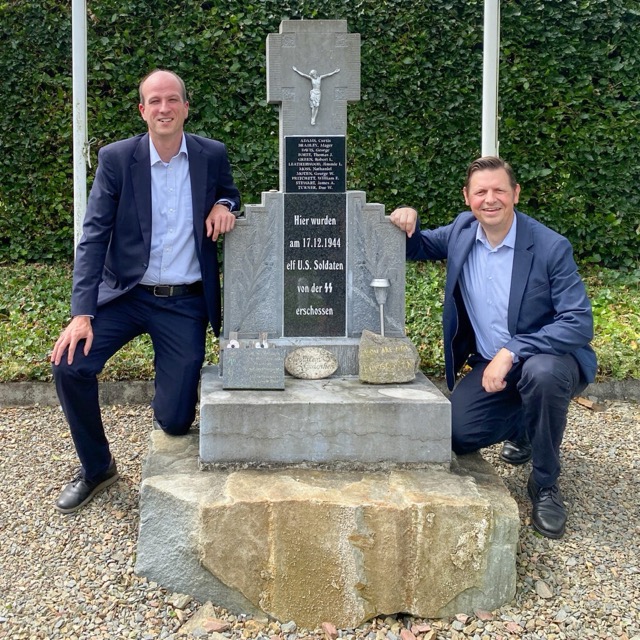A two-hour drive from Brussels, in a cow pasture in the hamlet of Wereth, Belgium, stands a stone monument so modest, it’s easily overlooked—particularly in the snow and fog of the Ardennes winter. There, on a morning in December 2020, a team from Embassy Belgium and community leaders held a private, socially distanced ceremony.
“Even with COVID or the weather—we go,” said Brian Dick, a historian and a longtime local staffer and supervisor of cultural affairs with the public affairs section of the U.S. Embassy . He’s been visiting the monument for a decade, often shepherding high-level guests and always accompanied by his longtime public affair’s colleague and multimedia specialist, Serge Vandendriessche. Presenters that day spoke without notes and “from the heart,” Dick remembered. “Commemoration is more than laying a wreath and going home.”
Perhaps nowhere is this clearer than here, the site of war crimes that were omitted from World War II history for 50 years.
Eleven U.S. soldiers—members of the segregated 333rd Field Artillery Battalion—hiked ten miles through deep snow and record-setting cold to escape Nazi Schutzstaffel SS troops after fighting on December 17, 1944, the second day of the Battle of the Bulge. The desperate men finally sought shelter in Wereth. They knocked on the Langer family’s door and were welcomed with warmth and food. But soon, a Nazi patrol arrived—likely tipped off by a neighbor in the German-speaking community—and marched the unarmed men away. Hermann Langer, just 12 years-old at the time, never forgot the soldiers seated at his kitchen table, nor what he later saw in the nearby pasture: the soldiers’ bodies following brutal torture.
Langer’s frustration simmered for decades as the event remained a local story—insufficiently investigated by the U.S. government and omitted from its 1948 official war crimes report—while the massacre of white soldiers in nearby Malmedy on the same day became well-known WWII history. In 1994, he constructed a monument to the “Wereth 11” himself. Early ceremonies drew a couple dozen people, including U.S. military personnel based in Germany, yet the monument remained unknown to a wider audience in its remote location and unmentioned in Battle of the Bulge guidebooks.
Making amends for this injustice means keeping commemoration at Wereth a top embassy priority.
“Despite the fact that this story took place more than 70 years ago, it’s part of the DNA of our U.S.-Belgian relationship—the U.S.-European one too,” said Dick. “It humanizes that partnership.” This commemoration work depends on people—in Wereth, Belgium, and beyond—finding connection and purpose through the story’s message that bravery and compassion are possible in the cruelest circumstances. “These are ideals you want to believe in,” said Vandendriessche, documentarian of the story’s unfolding legacy.
Meaningful commemoration springs from local roots, Dick has found through his work at Belgium’s many sites honoring fallen U.S. service members.
“Without the Langer family,” he said, “academics may have eventually found a footnote about the massacre and written a research book, but we are looking for a broader connection,” as are volunteers in Belgium and the United States who purchased land around the monument and enlisted municipal government help to develop it into the U.S. Wereth Memorial.
By the time Dick attended his first ceremony there, a plaque had been installed dedicating the site to the 1.2 million Black soldiers who fought in WWII—the only known monument of its kind in Europe.
“It’s something you have to experience to understand the profundity,” Dick says of visiting the site and his motivation for enlisting the embassy to boost the grassroots campaign seeking a rightful place in history for the Wereth 11 story. “We all have the same goal.” Achieving it, he said, depends less on the smooth choreography of flags, flowers, and formalities and more on relationships—in particular, with a dedicated “local engine.” That person has been Solange Dekeyser, a former guide at Belgium’s Henri-Chapelle American Cemetery. She promised Hermann Langer, shortly before his death in 2013, to carry on the Wereth 11 commemoration, and she has done so tirelessly. According to Dick, “energizers” like Dekeyser keep commemoration efforts like these from foundering. Likewise, Dekeyser believes that without embassy support the Wereth 11 legacy would be less secure.
Within this dynamic partnership, Dick is mindful of the embassy’s delicate position, the “fine line between investing in and owning the story.” The primary goal isn’t leveraging the embassy’s convening power to overwhelm the small site, but rather involving the embassy—up to the ambassadorial level—in the collective process of remembering the Wereth story and its significance.
Ceremonies start quietly at the Langer home, which still holds the original table where the eleven men sat, and continue in a procession retracing their path to the cow pasture. With a storyteller’s eye, Vandendriessche captures Belgians and Americans—among them, descendants of the 11 men and the Langer family—who help turn the Wereth 11 story into living history.
“I record what I see and let the story tell itself,” said Vandendriessche.
His images document an ever-growing community in which connections to the story reinforce relationships with each other.
“People come because they want to be part of something,” Dekeyser said of the “big family” that has formed around the commemoration, booking up local hotels for Memorial Day each year and sharing meals after the ceremony.
Longevity was Langer’s goal when he chose granite for the monument, according to his family. Longevity is still the goal today: How can commemoration build relationships that sustain the story’s momentum across generations—independently of an indefatigable local organizer and a committed embassy team? Fortunately, Battle of the Bulge guidebooks now include Wereth, and in 2017, Congress finally added the war crimes to the official record. On the ground, Vandendriessche documents evidence of the story’s traction, such as WWII veterans arriving in Wereth to pay respects after Bastogne’s grand 75th anniversary of the Battle of the Bulge ceremony.
“Buses full of people come to see this simple, modest ceremony,” he said. “This story is out there now—and it’s big.”
As Dick savors this progress, he also wonders, “Who will continue this work?” To help this history feel relevant to young people “we must adapt, modernize, and continuously ask ourselves, ‘Why are we doing this?’” said Dick. “‘Because we’ve always done it this way,’ is not a good answer.’”
An embassy-sponsored student exchange in 2017 yielded an unforgettable Memorial Day event staged by Morehouse College students. “The soldiers were brought to life,” remembered Dekeyser. Young men from the historically Black college—located in the same U.S. region that was home to the Wereth 11—wrote and performed monologues imagining the soldiers’ thoughts before death, bringing the audience to tears.
Wereth exchange students who visited Morehouse College in 2017 returned to overhaul the memorial website and take the podium at ceremonies. Seeing them “show up at events and rethink ways to keep the story relevant” reassures Dick that innovative and meaningful commemoration will continue at Wereth.

